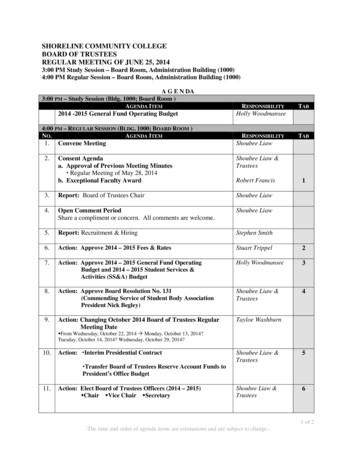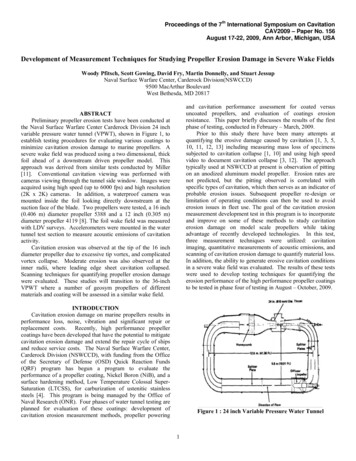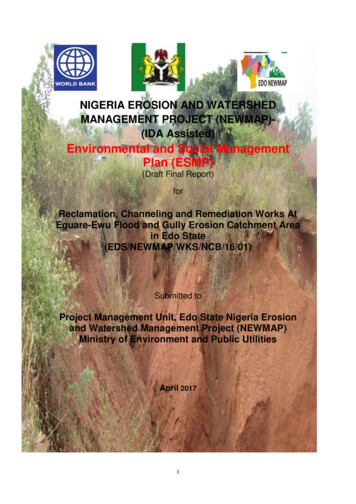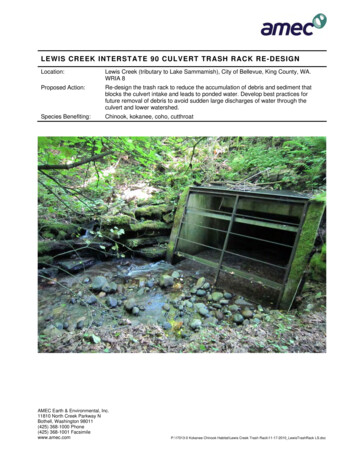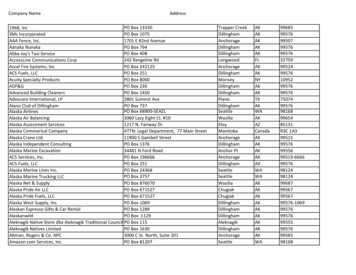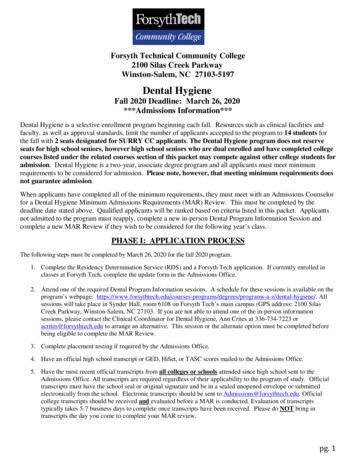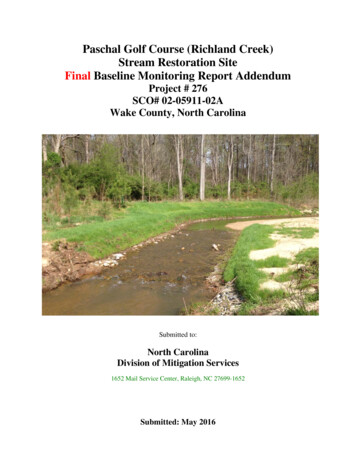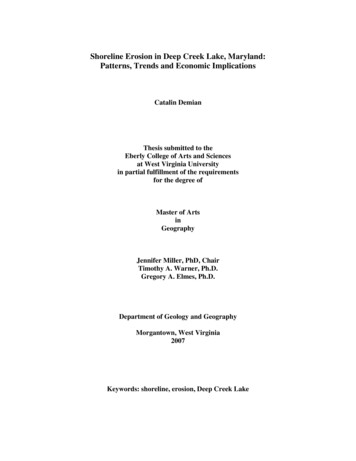
Transcription
Shoreline Erosion in Deep Creek Lake, Maryland:Patterns, Trends and Economic ImplicationsCatalin DemianThesis submitted to theEberly College of Arts and Sciencesat West Virginia Universityin partial fulfillment of the requirementsfor the degree ofMaster of ArtsinGeographyJennifer Miller, PhD, ChairTimothy A. Warner, Ph.D.Gregory A. Elmes, Ph.D.Department of Geology and GeographyMorgantown, West Virginia2007Keywords: shoreline, erosion, Deep Creek Lake
ABSTRACTShoreline Erosion in Deep Creek Lake, Maryland:Patterns, Trends and Economic ImplicationsCatalin DemianDeep Creek Lake, Maryland was constructed in the 1930s as a reservoir for a hydro-electricproject, but it also has been used for recreational purposes. Property ownership is attractive, butlakefront properties in particular are exposed to shoreline erosion. A particular issue is the Stateof Maryland’s ownership of the shoreline and the buffer strip. While most of shoreline erosionoccurs technically on state-owned land, not the lakeshore private property, erosion’s most visibleeffects are property improvements damage or gradual decrease in the distance between the lakeand the property improvement. In order to understand the magnitude of the problem, to observepatterns for shoreline erosion and to help better planning of development in the region, one of theobjectives of the present study was to map and, to the extent possible, to quantify shorelineerosion on Deep Creek Lake. Another objective of the study was to collect information aboutactual erosion directly from owners of lakefront properties and to assess their experiences andperceptions of shoreline erosion hazards on their property. In order to achieve the first objective,the study used historical aerial photographs. The highest water marks on previously rectifiedaerial photographs were traced in ArcView 9.1. Digitized shorelines from multiple years wereoverlain, followed by the spatial adjustment of vectorized shoreline. For the second objective ofthe study, a survey of lakefront property owners was conducted. The result of the digitizationprocedure showed that in many sectors the shoreline receded from the original location, whereasin some sectors the shore protracted. The findings from the owners’ survey (sample size 323;return rate: 67.4 percent) suggest that almost 70 percent of properties have undergone some formof erosion and that those owners who reported such events are more likely to be aware ofpotential causes and mechanisms of erosion on the shoreline of their property. The limitations ofthe study include the fact that a qualitative analysis of shoreline change cannot be descriptiveenough if changes are only on a small scale and that self-reported data can overestimate thelocation and/or extent of erosion. The study found that there is erosion in Deep Creek Lake andthe property owners are aware of the process, but additional information is needed in order toquantify the erosion, to map it and establish its patterns.
AcknowledgementsI would like to thank my committee members, Dr. Jennifer Miller, Dr. Timothy Warnerand Dr. Gregory Elmes for their assistance and significant contributions. I offer special thanks toCarolyn Mathews (Lake Manager) and Julie Allbrooks (Assistant Lake Manager) from DeepCreek Lake NRMA, to Paul Durham (retired Lake Manager) and to Scott Johnson (President ofDeep Creek Lake Property Owners Association) for providing valuable information in support ofthis research. My appreciation goes toward Prof. Harun Rasid (Chair of the Department ofGeography & Earth Science at the University of Wisconsin) for his permission to use the surveyquestionnaire and feedback in adapting it to this study.This study was also possible thank to West Virginia View, which provided financialassistance for both the digitization and the survey, and to West Virginia GIS Technical Centerfor providing the necessary professional and financial foundation for my Research Assistantposition.Many fellow students helped me through my graduate studies. In particular I would liketo thank George Roedl and Denyse Wyskup for their support and suggestions.Finally, I extend my sincere appreciation to my family and friends, for supportingeverything that I have done, not only here at West Virginia University, but throughout my entirelife.iii
List of Figures and TablesFiguresFigure 1.Figure 2.Figure 3.Figure 4.Figure 5.Figure 6.Figure 7.Figure 8.Deep Creek Lake, Maryland and surrounding statesZip codes for Deep Creek Lake, MarylandGeo-referenced 1938 Deep Creek Lake aerial photographLakeshore tracing on digitized 1938 Deep Creek Lakeaerial photographLiniar interpolation of the shoreline DEM with the digitized1938 Deep Creek Lake shorelineSpatial adjustment for the 1988 shoreline of Deep Creek Lake(Northwestern)Overlays of 1938 (light blue), 1962 (pink), and 1988 (dark blue)Deep Creek Lake shorelineDistribution of respondent Deep Creek Lake addressesFigure 9. Distribution of erosion-related events in Deep Creek LakePage31115161718232526TablesTable 1. Characteristics of the lakeshore property ownership inDeep Creek Lake, MarylandTable 2. Mean number of years since a specific erosion-related eventhas occurredTable 3. Relationship between the importance attributed to causes oferosion problems and experience of erosion on lakefront propertyiv242728
List of AppendicesAppendix A. West Virginia University Institutional Review Board ApprovalAppendix B. Survey QuestionnairevPage3839
Chapter 1. IntroductionLakefront property ownership in Deep Creek Lake has been constantly attractive forbuyers in search of vacation homes in this Western Maryland recreational area. On the local realestate market, lakefront houses and/or land come with the highest price tag in the entire area.Unfortunately, some lakefront owners face threats to the property and its financial value in theform of land loss or structure damage due to shoreline erosion. In technical terms, a propertyimprovement is any kind of structure built by the owner on the property (such as a dock, a shed,a house, or another structure). Property losses are characterized by a gradual decrease in thedistance between the lake and property improvements, which, if allowed to continue, diminishthe resale value of the property and eventually threaten property improvements with collapse intothe lake. The original boundary line was established by the electrical company which built thelake. Generally, the so-called “buffer strip” consists of at least 25 feet of land. The width of thebuffer area varies with elevation and ranges from a few feet in sections where the lake shore issteep to several hundred yards when the land is a gradual slope away from the lake. A particularissue in Deep Creek Lake is the State of Maryland’s ownership of the shoreline and the bufferstrip. While most of shoreline erosion occurs technically on state-owned land, not the lakeshoreprivate property, erosion’s most visible effects are property improvements damage or gradualdecrease in the distance between the lake and the property improvement. Residents whoseproperties appear to have been affected by shoreline erosion have voiced their concerns (DeepCreek Dispatch n/d; EMR, Inc., 2004) and some have applied for permits to build erosionprotection structures on their property. Currently, the Maryland Department of Environment(MDE) reviews and approves or denies the shoreline erosion control structures. Subsequently,Deep Creek Lake Natural Resources Management Area (NRMA) permits the work if is has been1
approved by MDE. Whether local government should take responsibility in assisting financiallythese owners is a controversial issue, and currently MDE does not share the costs of suchprojects.2
Chapter 2. Context of Shoreline Erosion in Deep Creek Lake2.1: Geographic LocationDeep Creek Lake is located in Garrett County, the westernmost county in Maryland, withan area of 662 square miles and a shoreline of approximately 65 miles. Garrett County has apopulation of approximately 29,909 (U.S. Census Bureau n/d), being the least populated countyin Maryland. The Deep Creek Lake watershed is bounded by several mountains, includingMarsh Mountain, Meadow Mountain, Snaggy Mountain, and Roman Nose Hill.Figure 1: Deep Creek Lake, MD and surrounding statesThe lake was created in 1928 by the Pennsylvania Electric Company, a private companythat bought all the land and built the dam. Deep Creek Lake hydroelectric project wasconstructed on Deep Creek, a tributary of the Youghiogheny River, by flooding a section ofYoughiogheny River valley. As a result, the lake is long, narrow and has a convoluted shoreline.Over the next few decades, the Deep Creek Lake region developed as a recreational resort, with3
the human presence and activities on and around the lake intensifying in the last 15 years (EMR,Inc., 2004).2.2: Overview of Potential Determinants of Shoreline ErosionErosion represents the process of weathering (i.e. the physical process - eithermechanically or chemically - of changing the character of rock at or near the earth surface),followed by physical removal of rock particles from their original position (Tarbuck and Lutgens1987). Based on how rock particles are removed, erosion can be induced by five different typesof mechanisms: (1) rain and stream action, (2) the action of glaciers, (3) the action of wind, (4)action of waves, and (5) the action of forces within the Earth. Given the history and physicalgeography particularities of the region, the predominant natural cause of erosion in Deep CreekLake appears to be the action of waves on the shoreline (Deep Creek Lake recreation and landuse plan, 2001; EMR Inc., 2004). Shoreline erosion at Deep Creek Lake is rarely a single eventas much as it is an ongoing process that doesn’t get recognized as a problem until trees aretoppled or lakefront property owners have to relocate shoreline-added structures or theirembankment topples into the lake. On the other hand, the property owners are in manycircumstances the ones removing, cutting and trimming soil-stabilizing vegetation along theshoreline (Carolyn Matthews, Manager, Deep Creek Lake NRMA, April 30, e-mail).Major storms are rarely erosion-producing events in Deep Creek Lake. Lake levelfluctuations (induced by hydroelectric project operations) represent a dominant influence ofhuman factors on the process of erosion. In addition, because of the recreational nature of mosthuman activities on the lake (boating and watercraft activities), especially during warm months,the action of waves in inducing shoreline erosion could be thus exacerbated (EMR, Inc., 2004;Canadian Coastguard/Erosion and Boatwake n/d).4
2.3: Physical CharacteristicsFrom the viewpoint of physical geography, topography and vegetation determine thecharacteristics of a landscape. The topography is the result of the nature of the rocks, theirexternal or internal characteristics and the types of soils.The elevation in Western Maryland increases gradually across the Coastal Plain and thenmore rapidly until the highest point and elevation are reached on the Allegheny Plateau, which isa sector of Appalachian Mountains. The Allegheny Plateau extends westward from Dan’sMountain through the rest of the state. The general aspect shows elongated ridges fromsouthwest to northeast. The topographic elevation of Deep Creek Lake area is an expression ofgeologic history and the varying erosive rates of different rocks in time. This physical activitycreated an elevation that varies from 2,000 feet to more than 3000 feet above the sea level.Through the understanding of the topography other features influencing development in the areacan be explained. The soils are strongly influenced by water level. It is especially true for soildrainage characteristics and adjacent with these, vegetation and even wildlife. Slope is animportant factor in determining suitability of land for different uses.Deep Creek Lake is located entirely within the Allegheny Plateau, the westernmostgeographical region of Maryland. In geologic terms the Alleghenies are old hills, and theirhistory started more than 500 millions years ago during the Paleozoic Era, in the Late Ordovicianor Early Silurian, and Devonian period (Tarbuck and Lutgens 1987; Kiver and Harris 1999). Formore than 200 million years, the ocean filled the region now occupied by the AppalachianPlateau and sediments from eroding uplands washed into area, slowly adding to the accumulativedebris of marine skeletons. The abundance of fossils is evidence of the fact that this area wasunder the water. The geologic event known as Appalachian Orogeny, in the Carboniferous5
period, with its Mississippian and Pennsylvanian epochs, occurred and the region was uplifted.The Pennsylvanian period, also called “The Coal Age”, followed occurring around 325-286millions years ago. The shoreline included in this study is located on a syncline called theCasselman Basin. The Meadow Mountain is the eastern border of this formation. The sedimentsexposed here are brown colored sandstones and shales of Mauch Chunk formation. A very thicklayer of Greenbrier Limestone underlies the lake and contributes with calcium carbonate tobuffer the lake waters from acidic runoff due to the younger formations of sandstone, shale, andcoal.The five major factors in the formation of soils are parent material, climate, livingorganisms, topography, and time. There are 6 types of soil associations ((Stone and Matthews1974) in Garrett County, MD: 1) Calvin-Gilpin (29%); 2) Gilpin-Cookport-Dekalb (9%); 3)Gilpin-Wharton-Dekalb (5%); 4) Lickdale-Armagh-Peat (1%); 5) Dekalb-Calvin-Gilpin (14%);and 6) Dekalb-Gilpin-Cookport (42%). In and around the study area, three major associations ofsoils, Calvin-Gilpin, Dekalb-Calvin-Gilpin, and Dekalb-Gilpin-Cookport are identified. Theseassociations have in common specific characteristics such as gently sloping to steep, moderatelydeep, and good drainage soils; most are very stony loams or silt loams. The area South to thelake is represented by the Calvin-Gilpin association, but also has 30 percent of less extensivesoils. In the area surrounding the Northern sector of the lake, Dekalb-Calvin-Gilpin and DecalbGilpin-Cookport are the most dominant associations. The Dekalb-Gilpin-Cookport associationoccupies almost 42 percent of the county and more than 60 percent of the Northwestern sector.Except for isolated areas, this association is not used for cultivated crops. Small areas were usedfor forage crops and pasture, but generally the association is used for woodland, wildlife habitat,watershed protection, and outdoor recreation.6
Ranking second in importance after the geological aspects in the erosion process of thearea of study, the climate, through its components (precipitation, temperature, and seasonalvariability), acts upon the bedrock. Garrett County has a humid, temperate, continental climate.The climate is fairly uniform throughout the county, although there are local differences inweather at different elevations and in relation to the lake. Average monthly temperatures inwinter are below freezing and average monthly temperatures in summer are typically over 20 C.Overall, there are no significant differences among soils of the county caused by climate alone(Stone and Matthews 1974). As mentioned, storms rarely occur.Approximately 90 percent of the Deep Creek Lake shoreline's natural character has beenimpacted by residential and commercial development to various degrees (Deep Creek Lakerecreation and land use plan, 2001). In early development areas, wherever smoother slopesallowed, the shoreline is completely deforested and replaced with grassy patches, while there areseveral areas of the lake that still maintain their natural appearance with minimum or nodisturbance. The forest cover along the buffer strip is generally fragmented.2.4: Lake Level RegulationsIn 1968, the Pennsylvania Electric Company (PENELEC), at that time owner of the lakeand surrounding properties, was issued by the Federal Energy Regulatory Commission (FERC) alicense to operate the Deep Creek Lake hydroelectric project. PENELEC, as the lake owner atthat time, had established its own policies and procedures for managing the lake, which alsoextended over the recreation area and the access to Deep Creek Lake.Lake management regulations were promulgated through a public process beginning in1981 and were updated in 1986, 1988, 1989, and 2000. These regulations (COMAR Title 08,7
2006) are still in effect and provide the basis for lake management operations conducted by theMaryland Department of Natural Resources (DNR).In 1991, FERC determined that the federal government should not maintain jurisdictionover the Deep Creek Lake project. Therefore, the water appropriation permit issued by the Stateof Maryland in 1994 guided the maintenance of the lake levels and discharges for generation ofhydroelectric power. In 1999, General Public Utility, PENELEC’s holding corporation and theState of Maryland started to negotiate the purchase of the bottom, buffer zone properties andother parcels owned by the power company. The sale was completed in 2000, but the State ofMaryland did not buy the dam, intake tunnel, and power plant. These assets were sold to SitheEnergies at the time, currently the owner being Brookfield Power.Discharges from Deep Creek Hydroelectric Station enter the Youghiogheny River. Thiswater discharge has the potential to affect recreational activities on the lake through changes inthe lake’s water level, as well as downstream environment of the river. Because the interests ofvarious users of Deep Creek Lake’s resources are potentially conflicting, a plan was developedduring the re-licensing and permitting process, to find balanced solutions to a variety of complexenvironmental and recreational issues in conjunction with economical operation of the powerplant.The plan is implemented through the Water Appropriation and Use Permit for DeepCreek Lake Station (Deep Creek Lake recreation and land use plan, 2001), which requires therelease or retention of water for various in-lake and downstream uses. The scheduled release isevery Monday and Friday and one Saturday per month during the whitewater recreation season(April 15-October 15). These releases are to last at least 3 hours when sufficient water isavailable and they cannot be curtailed unless the lake level is 1 foot or more below the lower8
operating rule band (for Friday release) or below the lower rule band (for Monday and Saturdayrelease). The permit also requires the owner of the power plant to make releases to maintainriver water temperature below 250C for trout habitat during the summer.2.5: Recreational Watercraft ActivitiesThree basic types of boats are utilized on Deep Creek Lake: power boats, sail boats andhuman powered boats. Boating activity is at a peak during spring and summer weekends.According to a 2004 carrying capacity study (EMR, Inc., 2004), overall boating activity duringnon-peak times was well within carrying capacity limits. Water skiing, wake boarding andtubing are popular at Deep Creek Lake. Windsurfing also occurs. These uses also tend to be attheir highest levels during the peak boating periods of spring/summer weekends. The operationof personal water craft is restricted on the lake during summer peak-use boating periods. As aparticularly interesting note, according to the present study, the lakefront property owners ingeneral tend to believe that the usual level of recreational boating on the lake, besides othernuisances, induces waves that affect the shoreline by producing erosion.2.6: Lakefront Property HazardsBeing primarily a recreational area, the lakefront was particularly attractive for buildingresidential and commercial structures. The Garrett County Planning and Zoning establishesprivate property development setbacks from adjacent property and from the water line.According to Phillips and Rasid (1996) the types of erosion damages commonly found ininland lakes are: beach erosion and loss of land/property; loss of trees/landscaping; and damageto lakeshore structures (such as boating docks, retaining wall or even public roads). Theliterature on lakeshore engineering (Carter et al. 1987; Charlier and de Meyer 1997; Gibson et al.2002) suggests that the extent of lakefront property damage can be determined by three factors9
occurring in various combinations: 1) the natural erodibility of the land; 2) the distance at whichproperty improvements are set back from the shore; and 3) the presence of an erosion controlstructure. Natural erodibility can be determined by the Universal Soil Loss Equation (USLE).This equation predicts the long term average annual rate of erosion on a field slope by usingnumerical estimate of rainfall pattern, soil type, topography, crop system and managementpractices (Charlier and de Meyer 1997). It only predicts the amount of soil loss that results fromsheet or rill erosion on a single slope and does not account for additional soil losses that mightoccur from gully, wind or tillage erosion. In theory, a high degree of erodibility could be used asa deterrent to erecting structures on that section of the shore, and could also determine the widthof the setback regulated by the authority issuing the permit.Because the buffer strip of the shoreline is actually owned by Maryland DNR, the stateregulates the kind of shore erosion control measures that can be applied in case of damagecausing erosion. DNR, through Deep Creek Lake Natural Resources Management Area(NRMA) previews each individual application in order to be assured there is no other recourse tostabilization than building a shoreline erosion control structure. If less invasive alternatives arenot going to rectify the situation then the permit application is forwarded to the MarylandDepartment of Environment (MDE). MDE reviews the application, inspects the site andapproves or declines the request for shoreline erosion control structures.2.7: Study SiteThe shoreline on Deep Creek Lake is 65 miles long and most of it is occupied by structuresowned by almost 2,000 individual owners of residential and commercial properties, as well asthe Deep Creek Lake State Park. Generally the lake can be divided into three sectors, Northern,Central, and Southern (EMR, Inc., 2004). Different sections of the lake are also referred to10
according to the name of prominent geographic landmarks such as McHenry and Thayerville(areas with the most intense residential development) or Turkey Neck (an area with intenseboating). According to the zip code of the physical address of the property, there are 3 sections:McHenry (21541), Oakland (21550), and Swanton (21561) (Figure 2).Figure 2. Zip codes for Deep Creek Lake, Maryland2.8: Exploring Owner Perceptions of Shoreline Erosion HazardsDeep Creek Lake was created originally as a resource for hydroelectric power for theregion’s development and only later did it become a recreational point of interest. Theownership over the shoreline appears a particular, potentially conflict-generating combination.11
While individuals own lakefront properties, a buffer strip of variable width is owned by the state.To add to the complexity of the situation, the region is currently viewed as an income generatorfor the entire Garrett County, with profits coming from recreational activities. All these elementshave led to more or less open conflicts of interests between the state, the operator of thehydroelectric project, and the individual owners. This situation is not unique to Deep CreekLake. In previous studies (Charlier and de Meyer 1997; Dilley and Rasid 1990; Phillips andRasid 1996) attempts were made to explore what the owners think about this kind of situationand how a compromise can be reached between public interest and individual interest. However,these studies focused on larger bodies of water, where national and international interestsintersect. To date, no previous study was found to explore issues of local or regional importance.12
Chapter 3. Goals and ObjectivesInformation about erosion occurrence in Deep Creek Lake is mostly anecdotal, and therehas been no systematic attempt so far to demonstrate that erosion has indeed occurred, and if itindeed exists, to map it or to better understand its determining causes. The Deep Creek LakeRecreation and Land Use Plan issued in 2001 recommended that a scientific study of this topicbe undertaken, and the owners’ association publicly supported the idea Deep Creek Dispatchn/d). The goal of this study is to fill in the gap in knowledge regarding shoreline erosion in DeepCreek Lake and its consequences.The first objective of this project is to map and, to the extent possible, to quantifyshoreline erosion on Deep Creek Lake. The result could potentially offer a more accurateunderstanding of the magnitude of the problem, suggest patterns for shoreline erosion and helpbetter planning of development in the region.The second objective of the study is to collect information about actual erosion fromowners of lakefront properties in Deep Creek Lake. In addition, the study will assess theirexperiences and perceptions of shoreline erosion hazards on their property and what possiblecorrelation could be found between these experiences and perceptions of the physical process oferosion (Kreutzwiser 1987). Such assessment will hopefully be relevant for the management ofthe shoreline on Deep Creek Lake and possibly in other similar areas, because it could lead to aclearer understanding of responsibilities of both the local government agencies and the owners,and hence to less conflict of interests.13
Chapter 4. Study Methods4.1: Digitization of Shoreline Erosion in Deep Creek LakeDirect measurement of the distance between the shoreline and one arbitrary point on theground, and comparison of successive measurements over time could offer an exactunderstanding of the extent and location of erosion. However direct field measurements areimpractical and expensive, especially for smaller inland lakes like Deep Creek Lake. Digitalanalysis of high resolution photographs taken over defined temporal periods has been used as apractical alternative to direct measurements in estimating actual and projected recession of theshoreline (Fisher and Overton n/d; Gibeaut et al.n/d; Gibson et al. 2002; Hughes n/d). Howevercurrently there are no digital maps available for Garrett County, Maryland (where Deep CreekLake is located) therefore this study will test a different approach.Historical aerial photos for Garrett County, MD from different years (1938, 1962, and1988) were used. The photographs were obtained from a personal collection (John Ninesteel,Frostburg State University, Maryland) as scanned versions of the original and were georeferenced (state plane coordinate system). No additional information was provided about thephotographs. The shoreline was then digitized in ArcView 9.1 (ESRI, 2005). Figure 3exemplifies the outcome of this step for the 1938 aerial photographs. On these digitized imagesthe shoreline was mapped through onscreen digitization techniques (Gibson et al. 2002) bytracing the highest water marks on previously rectified aerial photos (Figure 4). A digitalelevation model (DEM) (resolution 30 m) was downloaded in September 2005 from the UnitedStates Geological Survey (USGS), and for the purpose of capturing the slope line an attempt tointerpolate a 3D line off the active surface was made (Figure 5).14
Figure 3. Geo-referenced 1938 Deep Creek Lake aerial photograph15
Figure 4. Lakeshore tracing on Digitized 1938 Deep Creek Lake aerial photograph16
Figure 5. Liniar interpolation of the shoreline DEM with the digitized 1938Deep Creek Lake shorelineHaving a resolution of 30 x 30 m, the 3D image displayed an excessively coarseappearance, rendering the DEM image inappropriate for the purposes of this study. Due to this17
technical detail, the subsequent steps were performed on original digitized aerial photographs.Digitized shorelines from multiple years were overlain in ArcView, followed by the spatialadjustment of vectorized shoreline (with the purpose of controlling for errors in interpretation ofregression/advancement of the shoreline). A qualitative assessment of shoreline change wasconducted in order to determine where and how much erosion occurred over time. Although theentire lakeshore was digitized, only one particular section- Northwestern- was examined in moredepth, because anecdotal reports most often referred to this particular section (Figure 6).Figure 6. Spatial adjustment for the 1988 shoreline of Deep Creek Lake (Northwestern)18
4.2: Survey of Property Owners to Determine Experiences and Perceptions of ShorelineErosion HazardsThe second goal of this study was to survey lakefront property owners about erosion andto measure perceptions about the causes of shoreline erosion problems as well as their attitudesregarding the responsibility for shoreline control interventions. This part of the study wasaccomplished using a cross-sectional design to determine owners’ attitudes. The rationale forusing a quantitative tool for measuring attitudes was to obtain results that may be a usefulreference in the near future, if recommendations from this study will be implemented. Aninnovative component was added to this study, consisting of a comparison of results from theshoreline digitization and location of self-reported erosion, thus attempting to validate bothtechniques. In other words, if images suggest that a shoreline change occurred in a certain sectorof the lakeshore and in the same time a significant proportion of the survey respondents reportederosion in the same location, then both techniques validate each other and can be used in thefuture to determine lakeshore erosion.The primary po
Catalin Demian Deep Creek Lake, Maryland was constructed in the 1930s as a reservoir for a hydro-electric project, but it also has been used for recreational purposes. Property ownership is attract

